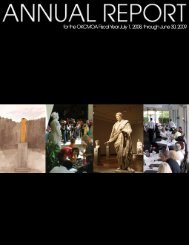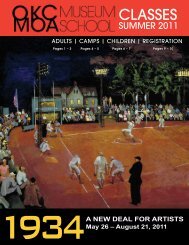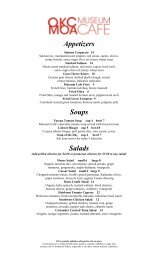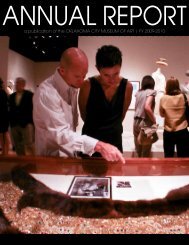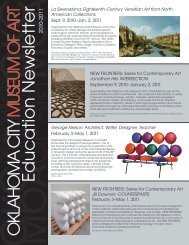Roman Art from the Louvre Educators' Resource Guide
Roman Art from the Louvre Educators' Resource Guide
Roman Art from the Louvre Educators' Resource Guide
You also want an ePaper? Increase the reach of your titles
YUMPU automatically turns print PDFs into web optimized ePapers that Google loves.
32<br />
Discussion Starters<br />
1. Describe <strong>the</strong> scene represented in this<br />
mosaic panel. How many figures do you<br />
see? Can you find <strong>the</strong> one carrying a glass<br />
carafe? A bread basket? What are <strong>the</strong><br />
figures doing? Are <strong>the</strong>y meant to appear<br />
as if <strong>the</strong>y are in motion or standing still?<br />
How can you tell? How are <strong>the</strong>y similar to<br />
or different <strong>from</strong> one ano<strong>the</strong>r?<br />
2. This mosaic shows a scene <strong>from</strong> daily<br />
life in <strong>the</strong> city of Carthage (near presentday<br />
Tunis). Based on <strong>the</strong> mosaic, what<br />
kind of city do you think Carthage was—an<br />
isolated city or a bustling international<br />
port? How does <strong>the</strong> mosaic reflect daily<br />
life in <strong>the</strong> <strong>Roman</strong> Empire?<br />
3. What do you think life was like for a<br />
slave in <strong>Roman</strong> times?<br />
4. What does this scene tell you about<br />
dinnertime in ancient Rome? Does it seem<br />
like many families dined toge<strong>the</strong>r, or did<br />
<strong>the</strong>y dine individually? What do people do<br />
at a dinner party today? How do our<br />
modern dining customs resemble or differ<br />
<strong>from</strong> those in <strong>the</strong> <strong>Roman</strong> Empire in <strong>the</strong> first<br />
century A.D.?<br />
5. At what occasions today might a<br />
seating arrangement be important? How is<br />
seating decided upon at <strong>the</strong>se occasions?<br />
Activity: Ancient <strong>Roman</strong> Vogue<br />
Materials: letter-sized white paper, glue,<br />
scissors, colored markers, hole punch or<br />
stapler; copies of <strong>the</strong> following images:<br />
Portrait of Augustus Wearing a Toga (no.<br />
3), Knife Handle in <strong>the</strong> Shape of a<br />
Thracian Gladiator (no. 6), and <strong>the</strong> mosaic<br />
panel shown here<br />
Procedure:<br />
Ancient <strong>Roman</strong>s dressed according to<br />
<strong>the</strong>ir social status. Only <strong>the</strong> emperor was<br />
allowed to wear a purple toga. Senators<br />
wore a white toga with a broad purple<br />
stripe along <strong>the</strong> border.<br />
1. Have students research <strong>the</strong> different<br />
types of clo<strong>the</strong>s, accessories, and<br />
hairstyles worn by <strong>the</strong> various types of<br />
people depicted in this exhibition.<br />
2. Have students create an ancient <strong>Roman</strong><br />
fashion magazine by drawing <strong>the</strong> clothing<br />
item, accessory, or hairstyle, or by cutting<br />
out images printed <strong>from</strong> <strong>the</strong> internet. Each<br />
item should have its own page.<br />
7. Mosaic Panel<br />
Late 2nd century A.D.<br />
Discovered near Carthage (Tunisia), 1875<br />
Marble, limestone, molten glass<br />
88L x 94H in.<br />
Musée du <strong>Louvre</strong>; Purchased in 1891 (MA1796–inv. mnc 1577)<br />
Dressed in short tunics, five young people carry utensils and food in preparation<br />
for a banquet. They are young triclinarii—slaves who served as<br />
waiters. Slaves are not easily distinguishable <strong>from</strong> commoners, since commoners<br />
also wore short tunics, but <strong>the</strong>y can usually be recognized by <strong>the</strong><br />
activities <strong>the</strong>y are shown engaging in—such as hunting, agricultural work,<br />
amphi<strong>the</strong>ater games, or banquet preparations. Banquet scenes and depictions<br />
of slaves were popular in North African floor decorations. Both reflect<br />
<strong>the</strong> desire among wealthy homeowners to showcase <strong>the</strong>ir way of life and<br />
prosperity.<br />
The figure at <strong>the</strong> center of <strong>the</strong> mosaic is <strong>the</strong> best preserved. In addition to<br />
a tunic, which is ornamented with two blue stripes, he also wears a loincloth<br />
knotted at <strong>the</strong> hips. He holds up a flat wicker basket containing four<br />
breads or cakes. To his left is ano<strong>the</strong>r slave with a small basket, probably<br />
of fruit. In <strong>the</strong> lower section is a young man, cut off at mid-body, who has<br />
a scarf over <strong>the</strong> neck of his red-striped tunic. He grasps a plate and a glass<br />
carafe, most likely filled with wine. To his right is a slave whose tunic covers<br />
<strong>the</strong> shoulder upon which a thick pole rests. No doubt <strong>the</strong> pole supported<br />
a heavy load. All that remains of <strong>the</strong> fifth slave is part of his leg and hand,<br />
which holds a large metal kettle.<br />
Most <strong>Roman</strong>s ate three meals a day. Breakfast and lunch were light meals<br />
often consumed out of <strong>the</strong> home, but dinner was always eaten at home and,<br />
for <strong>the</strong> wealthy, typically included three courses: an appetizer, entree, and<br />
dessert. When guests were attending, dinners became even more elaborate.<br />
The number of dishes increased and became more unusual, including<br />
entrees such as ostrich or flamingo. The host aimed to impress his<br />
guests with his wealth and good taste. Guests dined while reclining on<br />
couches that were arranged in a U-shape around a large table. The seating<br />
arrangement was very important, with guests placed according to rank. For<br />
banquets, <strong>the</strong> most beautiful slaves were chosen and assigned to attend to<br />
specific guests.




